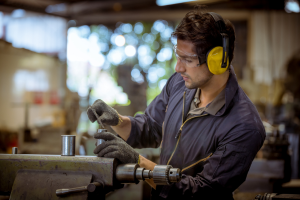By Niall Kelly on Thu 27 February 2025

Noise is a workplace hazard that should never be underestimated. While the damage may not always be as obvious as that caused by other hazards, it can have life changing effects and even lead to complete hearing loss. Therefore, it’s important that employers and safety officers are aware of the risks associated with noise in their workplace.
How is Noise Measured in Workplaces?
Noise is measured in decibels, dB (A). Anything above 80dB (A) is considered a risk.
What Sort of Risk do High Levels Pose for Workers?
When workers are exposed to high levels of noise, it poses a number of risks (both physiological and psychological) including tinnitus, hearing loss, and stress. High-level noise can be both continuous (e.g., angle grinding, hammering) or a loud sudden bang.
In addition, loud noises can hinder effective communication which can lead to accidents.
What Noise Level is ‘Too High’?
In Ireland, regulations stipulate that noise above 80dB (A) requires action to be taken. This is broken down into different ‘action levels’:
First Action Level:
This applies when the noise level is between 80dB (A) and 85dB (A). Here, employers must inform workers on the advisability of hearing protection and where to obtain same. They should also advise on hearing checks that are availabl
Second Action Level 85dB (A):
This applies when the noise level is above 85dB (A).
In this scenario, employers must have clearly visible and legible signs that state the noise level is likely to be in excess of 85dB (A). Employers must put in place measures to identify the cause of the high noise and take measures to reduce it where possible. They should also provide the services of a registered medical practitioner to conduct audiometric testing and hearing tests.
Whose Responsibility is it to Provide Hearing PPE?
In Ireland, it is the responsibility of the employer to provide sufficient ear protectors and to make sure that said PPE is suitable and adequate for their employees and the noise they’re exposed to. They should also make sure that the PPE chosen is a proper fit for each individual employee as ill-fitting PPE can become completely ineffective, and sometimes, a hazard itself. They should ensure that workers are properly trained in the use of their PPE.
Should we use Earmuffs or Earplugs as Hearing Protection?
The choice between earmuffs and earplugs as hearing PPE comes down to a few factors. For one thing, the type of work being carried out should be taken into consideration. For example, in dirty work environments, earplugs could cause an infection of the ear. You should also consider what other PPE the worker is wearing. For example, safety glasses have protruding armas which may prevent a tight seal between the earmuffs and the wearer’s head. In this scenario, earplugs may be preferable.
We hope that the above has given you an overview of why hearing PPE is important and the factors that should be considered when choosing it. Of course, it is not exhaustive, and we recommend a thorough analysis of your worksite noise levels and the type of work being undertaken when it comes to choosing hearing PPE. It is also worth important to emphasis that PPE is a last line of defense, and steps should also be taken to reduce the noise level wherever possible.
For more information, call our PPE experts at 0402 32116 (Arklow) or 021 484 1370 (Cork) and they’ll be happy to advise on the most appropriate hearing protection for your workers.
